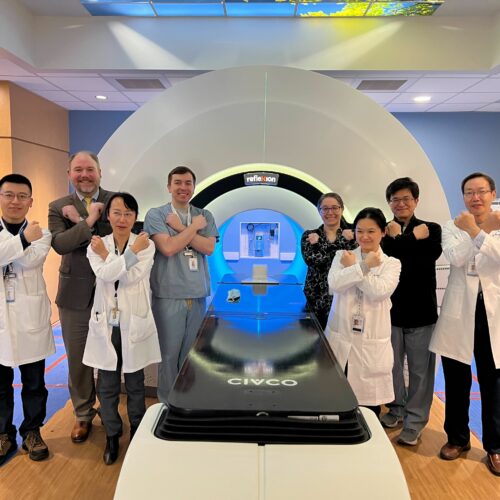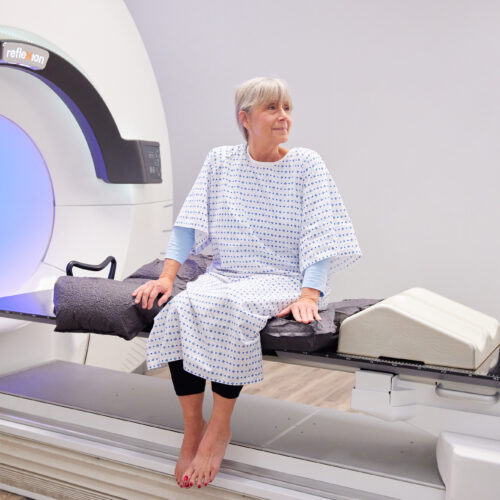
Metastatic Cancer
Understanding Radiation: The Unsung Cancer Therapy
April 16, 2019
Thanks for joining me again as we continue our discussion about metastatic cancer and its treatment. The last few posts centered around therapy, with an emphasis on drug therapy along with its successes and limitations. It made sense to start with drug therapy since this type of treatment can address the disease in both its visible (macroscopic) and invisible (microscopic) forms. In today’s post, we shift gears to radiotherapy, a very different kind of approach to eliminating cancer.
If drug therapy is the Michael Jordan of treatment in metastatic cancer, then radiation is the Scottie Pippen: A talented partner that enables Jordan to be at his best. For someone who does not appreciate basketball, it may be hard to watch an old Chicago Bulls game and really understand all the ways that Scottie Pippen created opportunities for Jordan with rebounds, assists, and fast breaks. Similarly, radiation can be a mysterious treatment option for many patients – and the many ways in which it supports the other parts of the treatment program may be easy to miss.
Interestingly, radiotherapy is among the oldest treatments for cancer. It was first used to treat cancer in the late 1800s, decades before chemotherapy was discovered and many of the major cancer surgeries were devised. Nonetheless, among the three pillars of treatment for cancer – drugs, surgery, and radiotherapy – radiotherapy has a reputation as the least understood. In my experience as an oncologist, I found that many patients had misgivings and misunderstandings about how this treatment works, its side effects, and its ultimate effectiveness. For many, even the term “radiation” could bring up visions of mushroom clouds in Hiroshima and fallout in Chernobyl. This wasn’t always the easiest place to start a conversation about cancer care. To help clear the air, I would start every new consultation with a metaphor that I will share with you.
Fortunately, understanding what a beam of radiotherapy does to a cancer cell is actually one of the most intuitive concepts in all of medicine. In the end, what radiation does to a cancer cell is not too different than what a speeding bullet does to an apple. This is because radiotherapy is ultimately just a stream of extremely small particles that are moving at break-neck speeds (up to and including the speed of light). Because of their miniscule size, these particles are also able to seamlessly travel through most forms of matter, including human tissue. Clinical radiotherapy, therefore, comes down to taking advantage of these features to carefully aim and shoot billions of tiny bullets at tumors deep inside the body.
From start to finish, this means that a radiotherapy clinic must do two things well: (1) Generate high-speed bullets and (2) Aim those bullets accurately at tumors. For the first part, the particles are sped up directly by large machines using magnets and electrical fields. These machines are rather unimaginatively called “accelerators.” A second way to get high-speed particles is to harvest them from substances that naturally eject them, like sparks shot out of a flame. You have probably heard the term “radioactive” to describe substances that naturally do this. Whether these fast-moving particles are generated in an accelerator or ejected from a radioactive substance, they carry momentum – again, like a bullet – and so they have the potential to shatter whatever is in their way.
Once we have the high-speed particles, the next part is predictable: We aim the source like a gun at tumors and shoot. As the individual cancer cells are pelted with billions of these bullets, they sustain fatal injuries. To understand this part in a little more detail, we have to switch from physics to biology. It turns out that the part of the cancer cell that is most vulnerable to being broken apart by these bullets is its DNA. Like nearly all cells in all living things on planet Earth, cancer cells depend on DNA to live, because DNA carries the genetic instructions necessary for a cell to function, grow, develop, and reproduce. If a cancer cell’s DNA is broken apart by our high-speed particles, the cancer cell itself is destined to die. And if you can kill all the cells that make up a tumor, then the tumor is controlled.
At this point in our conversation about guns and bullets, my patients would usually ask, “What about the normal cells around the tumor?” This is an incredibly important question, and patients are right to be concerned. It is also where things get really interesting. In fact, because radiotherapy particles keep moving past the exit wound in the cancer cell, potential innocent bystanders are standing both in front of and behind the tumor. Do these normal cells get harmed by the bullet? Does their DNA also break apart?
Fortunately, although the answer to these questions is “yes,” we can dramatically reduce the damage done to normal cells compared to cancer cells using at least three separate processes:
(1) The normal cells’ own biology
(2) Fractionation
(3) Precision
The first strategy – which employs natural differences in biology – is especially elegant: Normal cells in the body actually have DNA repair crews inside them (the slightly more scientific term is DNA repair enzymes). These crews are highly skilled at locating and repairing DNA injury caused by radiotherapy particles. They literally cement broken ends of DNA back together.
In practical terms, after a patient receives a session of radiotherapy, these DNA repair crews are activated and use the next 24 hours before the next session of radiation to patch up all the injuries in the bystander normal cells. While the patient is sleeping at night, these repair crews are putting the final touches on making the normal cell’s DNA look as good as new. Scientists have measured how well these DNA repair crews perform their jobs, and it turns out that they are extremely efficient at making these repairs with an exceedingly low error rate.
Unlike the situation in normal cells, however, cancer cells are inherently dysfunctional, and their internal machinery is chaotic. For this reason, they are much less able to make DNA repairs necessary to save themselves after exposure to radiation. Putting this all together, the biological differences between normal cells and cancer cells helps to separate the effect of radiotherapy on normal tissue and tumor even before physicians take any active measures. I have always found this to be one of the most remarkable features of radiotherapy.
In addition to this natural difference between normal cells and cancer cells, there are proactive ways that physicians can enhance the safety of radiotherapy. One of these approaches is called “fractionation,” which means delivering the total radiation dose in small pieces in order to be gentler on the normal tissues. This is related to the DNA repair story: In the normal cells, dividing the overall radiation dose means that each normal cell is better able to fully repair DNA damage each night. This makes intuitive sense: Repairing one broken window a day for five days is much easier than trying to repair five broken windows in a single 24 hour period. Meanwhile, in the cancer cells where DNA repair is poor, the injury mostly keeps accumulating even if we fractionate the treatment. From the tumor’s perspective, the collective damage in its cells is inflicted whether the radiation is delivered as one big shotgun blast or as death by a thousand cuts.
Finally, the third way that physicians routinely enhance tumor killing while sparing normal tissues is to enhance precision when targeting the radiation. In other words, if you can aim your particle gun more accurately, then less normal tissue is exposed to high doses of radiation in the first place. During most of radiotherapy’s history, precision was poor because physicians did not have the technology to accurately target tumors in the middle of the body that could move and twist with natural processes like breathing. I’m oversimplifying a bit here, but the default option was to aim large squares of radiation at the patient that accounted for all this uncertainty. Despite the liberal use of fractionation as a counterweight to radiating large fields, patients still experienced meaningful side effects with this approach.
Thankfully, this large-field approach to delivering radiotherapy is becoming a thing of the past. A major development in the last two decades of radiotherapy has been the introduction of vast amounts of technology to visualize and track tumors inside the human body, which in turn has enabled us to aim more directly at the tumor itself rather than exposing large areas to radiation just for good measure. This has empowered a shift away from radiotherapy as an artillery shell to something more like a sniper’s bullet. And in fact, the best way to describe modern radiotherapy delivery is to imagine multiple snipers around the target – each sniper’s bullet does not do much damage on its own as it enters or exits the body, but all the bullets coming from different directions overlap in a small, precise killing zone that contains the tumor.
Another positive development related to improved precision with technology is that oncologists are now more confident in delivering large doses of radiation to tumors safely. In other words, more precision means less reliance on fractionation to protect normal tissues. With this paradigm shift, we have seen the treatment course for certain cancers dramatically shrink from thirty gentle fractions of radiotherapy to five or less precise, high-dose sessions. This obviously is a boon for patients who can undergo treatment courses that are much more convenient and less disruptive to their lives. One of the most gratifying things about my practice was to tell my patients with one kind of common cancer, early-stage nonsmall cell lung cancer, that they only needed to spend about an hour a day with me for four days – wide awake and without general anesthesia – to get a complete radiotherapy treatment. In fact, for this particular disease, this short treatment course actually constituted their entire cancer treatment program. My patients were very pleasantly surprised that most of them could expect to go back to their hobbies, activities, and family life literally the next day after the 4 short sessions were done.
To be sure, the field of radiotherapy has done much to enhance the experience of treatment by reducing the duration of treatment and the side effects of radiation using all the techniques I mentioned above. However, it would be wrong to imply that we have eliminated side effects entirely. Ultimately, no matter how much we do to reduce the exposure of normal tissues to radiation, we cannot entirely eliminate some bystander effects from occurring, especially among tissues that are directly in contact with the target tumor. To complete this post, we will briefly discuss the toxicities of radiotherapy.
The first thing to note is that, unlike drug therapy, radiotherapy of the sort we’re describing here does not circulate in the bloodstream to all parts of the body*. Therefore, its effects are limited to the tissues surrounding the tumor that is being targeted rather than affecting organs far away from the tumor. In other words, the side effects are local rather than body-wide. Furthermore, we can divide these local side effects into two broad categories: Early and Late. The early effects occur during or right after the treatment while the late effects can occur months or even years after therapy.
The early effects are due to the fact that radiation exposure induces local irritation and inflammation. Depending on the specific normal tissue, this inflammation can manifest as a rash (skin), sore throat (esophagus), nausea (stomach), or stinging upon urination (bladder). These effects are generally mitigated with the use of fractionation and precision, and physicians have become skillful at reducing these side effects with straightforward anti-inflammatory measures – such as creams for rashes or solutions for the sore throat. If care is not taken to deliver the radiotherapy accurately and safely, then these toxicities can be severe, but in most cases, they are mild to moderate in severity and manageable. In some cases where a sensitive normal tissue is right next to a deadly tumor, accepting a risk of more severe side effects is a decision made by patients and their physicians in order to achieve their goals of therapy. Fortunately, these early effects of radiotherapy generally resolve within two to six weeks of completing radiotherapy.
While these early side effects happen to nearly all patients to a degree, the late effects are rarer and tend to be meaningful for a minority of patients. Speaking in broad terms, they are the consequence of scar tissue laid down after the inflammation goes away. In most cases, scar tissue inside the body is not so different than scar tissue after a cut on the skin: It is there, but it does not necessarily have any impact on a patient’s quality of life. In rarer cases, this scar tissue can be meaningful and cause pain or dysfunction of the organ where it is laid down. For this reason, patients schedule follow-up with their radiation doctors every few months after treatment. The goals of these appointments are to address these side effects (if they occur) and to assess whether the cancer is in remission or active.
One other adverse event worth noting is that some of the changes caused by radiotherapy in normal cells can snowball into a new cancer many years after the treatment, an association that is also true for many chemotherapies. Thankfully, the risk of these secondary cancers appearing is very low and, even if they occur, usually many years are required for the secondary cancer to appear. For instance, a recent epidemiological analysis of breast cancer suggested that if 100 patients who received radiation as part of their treatment lived for an additional 10 years after their treatment, then only 1 would experience a secondary cancer from radiotherapy (1). For the typical patient who is recommended to have radiotherapy to maximize their outcome, the clear and present danger of the current cancer carries much higher risks than the low possibility of a secondary cancer many years later.
Finally, some of my patients would ask about the different kinds of particles that are out there in the atomic and subatomic realms. Perhaps they have heard of these particles from their science classes or even on television commercials advertising a special form of radiotherapy. Indeed, it is impressive that oncologists have harnessed a number of particles for radiotherapy, including protons, neutrons, electrons, photons, and even something larger called an alpha particle, which consists of two protons and two neutrons stuck together. Each of these particles has its own features, advantages, and disadvantages – just like different bullets have different calibers, grooves, widths, and so on. However, the fundamental mechanism of cancer cell killing remains the same with all of these particles. They are all fast moving projectiles with which we shoot to kill cancer.
We have barely scratched the surface of radiotherapy, and so we will dig deeper on this topic in next month’s post. We will go into more depth on how doctors decide on things like the dose and number of sessions of radiotherapy. What I am especially excited about discussing is how radiotherapy and drug therapies – each powerful on its own — can work together to get outstanding outcomes. After all, Michael Jordan was also great on his own, but I’m not sure that six NBA championships would have happened without Scottie Pippen.
Refs.
1. Burt, L. M., Ying, J., Poppe, M. M., Suneja, G., & Gaffney, D. K. (2017). Risk of secondary malignancies after radiation therapy for breast cancer: comprehensive results. The Breast, 35, 122-129.
*There is another form of therapeutic radiotherapy where radioactive chemicals are directly injected into the bloodstream, but this constitutes a fairly rare situation in the overall spectrum of radiation treatments for cancer.




